Ellipse(椭圆)
原滋原味的英文介绍,挺有意思!
http://mathworld.wolfram.com/Ellipse.html
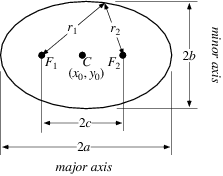
|

|
An ellipse is a curve that is the locus of all points in the plane the sum of whose distances  and
and  from two fixed points
from two fixed points  and
and  (the foci) separated by a distance of
(the foci) separated by a distance of  is a given positive constant
is a given positive constant  (Hilbert and Cohn-Vossen 1999, p. 2). This results in the two-center bipolar coordinate equation
(Hilbert and Cohn-Vossen 1999, p. 2). This results in the two-center bipolar coordinate equation

|
(1) |
where  is the semimajor axis and the origin of the coordinate system is at one of the foci. The corresponding parameter
is the semimajor axis and the origin of the coordinate system is at one of the foci. The corresponding parameter  is known as the semiminor axis.
is known as the semiminor axis.
The ellipse is a conic section and a Lissajous curve.
An ellipse can be specified in the Wolfram Language using Circle[ x, y
x, y ,
,  a, b
a, b ].
].
If the endpoints of a segment are moved along two intersecting lines, a fixed point on the segment (or on the line that prolongs it) describes an arc of an ellipse. This is known as the trammel construction of an ellipse (Eves 1965, p. 177).
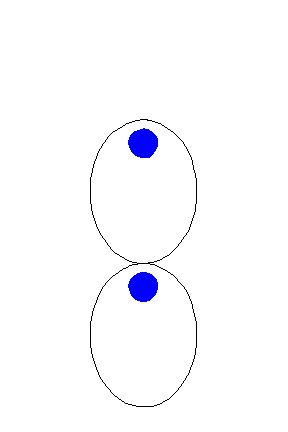
It is possible to construct elliptical gears that rotate smoothly against one another (Brown 1871, pp. 14-15; Reuleaux and Kennedy 1876, p. 70; Clark and Downward 1930; KMODDL).
The ellipse was first studied by Menaechmus, investigated by Euclid, and named by Apollonius. The focus and conic section directrix of an ellipse were considered by Pappus. In 1602, Kepler believed that the orbit of Mars was oval; he later discovered that it was an ellipse with the Sun at one focus. In fact, Kepler introduced the word "focus" and published his discovery in 1609. In 1705 Halley showed that the comet now named after him moved in an elliptical orbit around the Sun (MacTutor Archive). An ellipse rotated about its minor axis gives an oblate spheroid, while an ellipse rotated about its major axis gives a prolate spheroid.
A ray of light passing through a focus will pass through the other focus after a single bounce (Hilbert and Cohn-Vossen 1999, p. 3). Reflections not passing through a focus will be tangent to a confocal hyperbola or ellipse, depending on whether the ray passes between the foci or not.
Let an ellipse lie along the x-axis and find the equation of the figure (1) where  and
and  are at
are at  and
and  . In Cartesian coordinates,
. In Cartesian coordinates,

|
(2) |
Bring the second term to the right side and square both sides,

|
(3) |
Now solve for the square root term and simplify

|

|

|
(4) |

|

|

|
(5) |

|

|

|
(6) |
Square one final time to clear the remaining square root,

|
(7) |
Grouping the  terms then gives
terms then gives

|
(8) |
which can be written in the simple form

|
(9) |
Defining a new constant

|
(10) |
puts the equation in the particularly simple form

|
(11) |
The parameter  is called the semiminor axis by analogy with the parameter
is called the semiminor axis by analogy with the parameter  , which is called the semimajor axis (assuming
, which is called the semimajor axis (assuming  ). The fact that
). The fact that  as defined above is actually the semiminor axis is easily shown by letting
as defined above is actually the semiminor axis is easily shown by letting  and
and  be equal. Then two right triangles are produced, each with hypotenuse
be equal. Then two right triangles are produced, each with hypotenuse  , base
, base  , and height
, and height  . Since the largest distance along the minor axis will be achieved at this point,
. Since the largest distance along the minor axis will be achieved at this point,  is indeed the semiminor axis.
is indeed the semiminor axis.
If, instead of being centered at (0, 0), the center of the ellipse is at ( ,
,  ), equation (◇) becomes
), equation (◇) becomes

|
(12) |
As can be seen from the Cartesian equation for the ellipse, the curve can also be given by a simple parametric form analogous to that of a circle, but with the  and
and  coordinates having different scalings,
coordinates having different scalings,

|

|

|
(13) |

|

|

|
(14) |
The general quadratic curve

|
(15) |
is an ellipse when, after defining

|

|

|
(16) |

|

|

|
(17) |

|

|

|
(18) |
 ,
,  , and
, and  . Also assume the ellipse is nondegenerate (i.e., it is not a circle, so
. Also assume the ellipse is nondegenerate (i.e., it is not a circle, so  , and we have already established is not a point, since
, and we have already established is not a point, since  ). In that case, the center of the ellipse
). In that case, the center of the ellipse  is given by
is given by

|

|

|
(19) |

|

|

|
(20) |
the semi-axis lengths are

|

|

|
(21) |

|

|

|
(22) |
and the counterclockwise angle of rotation from the  -axis to the major axis of the ellipse is
-axis to the major axis of the ellipse is
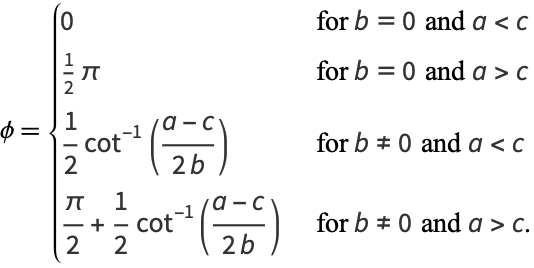
|
(23) |
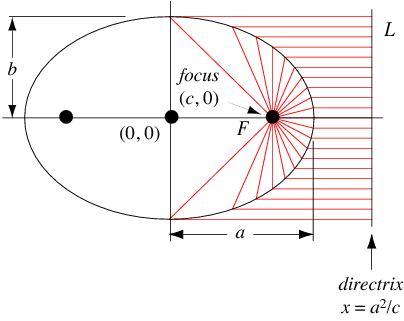
The ellipse can also be defined as the locus of points whose distance from the focus is proportional to the horizontal distance from a vertical line known as the conic section directrix, where the ratio is  . Letting
. Letting  be the ratio and
be the ratio and  the distance from the center at which the directrix lies, then in order for this to be true, it must hold at the extremes of the major and minor axes, so
the distance from the center at which the directrix lies, then in order for this to be true, it must hold at the extremes of the major and minor axes, so

|
(24) |
Solving gives

|

|

|
(25) |

|

|

|
(26) |
The focal parameter of the ellipse is

|

|

|
(27) |

|

|

|
(28) |

|

|

|
(29) |
where  is a characteristic of the ellipse known as the eccentricity, to be defined shortly.
is a characteristic of the ellipse known as the eccentricity, to be defined shortly.
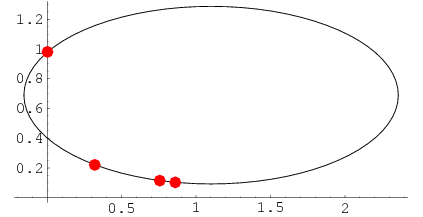
An ellipse whose axes are parallel to the coordinate axes is uniquely determined by any four non-concyclic points on it, and the ellipse passing through the four points  ,
,  ,
,  , and
, and  has equation
has equation
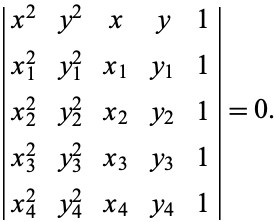
|
(30) |
Let four points on an ellipse with axes parallel to the coordinate axes have angular coordinates  for
for  , 2, 3, and 4. Such points are concyclic when
, 2, 3, and 4. Such points are concyclic when

|
(31) |
where the intermediate variable  has been defined (Berger et al. 1984; Trott 2006, pp. 39-40). Rather surprisingly, this same relationship results after simplification of the above where
has been defined (Berger et al. 1984; Trott 2006, pp. 39-40). Rather surprisingly, this same relationship results after simplification of the above where  is now interpreted as
is now interpreted as  . An equivalent, but more complicated, condition is given by
. An equivalent, but more complicated, condition is given by

|
(32) |
Like hyperbolas, noncircular ellipses have two distinct foci and two associated directrices, each conic section directrix being perpendicular to the line joining the two foci (Eves 1965, p. 275).
Define a new constant  called the eccentricity (where
called the eccentricity (where  is the case of a circle) to replace
is the case of a circle) to replace 

|
(33) |
from which it follows that

|

|

|
(34) |

|

|

|
(35) |

|

|

|
(36) |

|

|

|
(37) |

|

|

|
(38) |

|

|

|
(39) |
The eccentricity can therefore be interpreted as the position of the focus as a fraction of the semimajor axis.
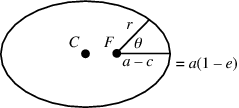
If  and
and  are measured from a focus
are measured from a focus  instead of from the center
instead of from the center  (as they commonly are in orbital mechanics) then the equations of the ellipse are
(as they commonly are in orbital mechanics) then the equations of the ellipse are

|

|

|
(40) |

|

|

|
(41) |
and (◇) becomes

|
(42) |
Clearing the denominators gives

|
(43) |
Substituting in  gives
gives

|
(44) |
Plugging in to re-express  and
and  in terms of
in terms of  and
and  ,
,

|
(45) |
Dividing by  and simplifying gives
and simplifying gives

|
(46) |
which can be solved for  to obtain
to obtain

|
(47) |
The sign can be determined by requiring that  must be positive. When
must be positive. When  , (47) becomes
, (47) becomes  , but since
, but since  is always positive, we must take the negative sign, so (47) becomes
is always positive, we must take the negative sign, so (47) becomes

|
(48) |

|
(49) |

|
(50) |
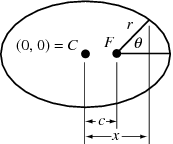
The distance from a focus to a point with horizontal coordinate  (where the origin is taken to lie at the center of the ellipse) is found from
(where the origin is taken to lie at the center of the ellipse) is found from

|
(51) |
Plugging this into (50) yields

|
(52) |

|
(53) |
In pedal coordinates with the pedal point at the focus, the equation of the ellipse is

|
(54) |
The arc length of the ellipse is

|

|

|
(55) |

|

|

|
(56) |

|

|

|
(57) |
where  is an incomplete elliptic integral of the second kind with elliptic modulus
is an incomplete elliptic integral of the second kind with elliptic modulus  (the eccentricity).
(the eccentricity).
The relationship between the polar angle from the ellipse center  and the parameter
and the parameter  follows from
follows from

|
(58) |
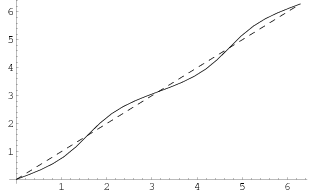
This function is illustrated above with  shown as the solid curve and
shown as the solid curve and  as the dashed, with
as the dashed, with  . Care must be taken to make sure that the correct branch of the inverse tangent function is used. As can be seen,
. Care must be taken to make sure that the correct branch of the inverse tangent function is used. As can be seen,  weaves back and forth around
weaves back and forth around  , with crossings occurring at multiples of
, with crossings occurring at multiples of  . The curvature and tangential angle of the ellipse are given by
. The curvature and tangential angle of the ellipse are given by

|

|

|
(59) |

|

|

|
(60) |
The entire perimeter  of the ellipse is given by setting
of the ellipse is given by setting  (corresponding to
(corresponding to  ), which is equivalent to four times the length of one of the ellipse's quadrants,
), which is equivalent to four times the length of one of the ellipse's quadrants,

|

|

|
(61) |

|

|

|
(62) |

|

|

|
(63) |
where  is a complete elliptic integral of the second kind with elliptic modulus
is a complete elliptic integral of the second kind with elliptic modulus  (the eccentricity). The perimeter can be computed using the rapidly converging Gauss-Kummer series as
(the eccentricity). The perimeter can be computed using the rapidly converging Gauss-Kummer series as

|

|

|
(64) |

|

|

|
(65) |
(OEIS A056981 and A056982), where  is a binomial coefficient and
is a binomial coefficient and

|
(66) |
This can also be written analytically as

|

|

|
(67) |

|

|

|
(68) |
where  is a hypergeometric function,
is a hypergeometric function,  is a complete elliptic integral of the first kind.
is a complete elliptic integral of the first kind.

Approximations to the perimeter include

|

|

|
(69) |

|

|

|
(70) |

|

|

|
(71) |
where the last two are due to Ramanujan (1913-1914), and (71) has a relative error of  for small values of
for small values of  . The error surfaces are illustrated above for these functions.
. The error surfaces are illustrated above for these functions.
The maximum and minimum distances from the focus are called the apoapsis and periapsis, and are given by

|

|

|
(72) |

|

|

|
(73) |
The area of an ellipse may be found by direct integration

|

|

|
(74) |

|

|

|
(75) |

|

|

|
(76) |

|

|

|
(77) |

|

|

|
(78) |

|

|

|
(79) |
The area can also be computed more simply by making the change of coordinates  and
and  from the elliptical region
from the elliptical region  to the new region
to the new region  . Then the equation becomes
. Then the equation becomes

|
(80) |
or  , so
, so  is a circle of radius
is a circle of radius  . Since
. Since

|
(81) |
the Jacobian is

|

|
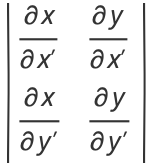
|
(82) |

|

|
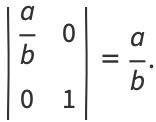
|
(83) |
The area is therefore

|

|

|
(84) |

|

|

|
(85) |

|

|

|
(86) |

|

|

|
(87) |
as before. The area of an arbitrary ellipse given by the quadratic equation

|
(88) |
is

|
(89) |
The area of an ellipse with semiaxes  and
and  with respect to a pedal point
with respect to a pedal point  is
is

|
(90) |
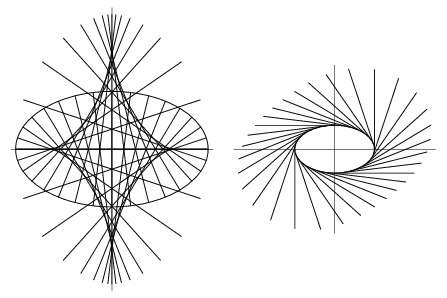
The unit tangent vector of the ellipse so parameterized is

|

|

|
(91) |

|

|

|
(92) |
A sequence of normal and tangent vectors are plotted above for the ellipse.
The locus of the apex of a variable cone containing an ellipse fixed in three-space is a hyperbola through the foci of the ellipse. In addition, the locus of the apex of a cone containing that hyperbola is the original ellipse. Furthermore, the eccentricities of the ellipse and hyperbola are reciprocals. The locus of centers of a Pappus chainof circles is an ellipse. Surprisingly, the locus of the end of a garage door mounted on rollers along a vertical track but extending beyond the track is a quadrant of an ellipse (Wells 1991, p. 66). (The envelope of the door's positions is an astroid.)
REFERENCES:
Abbott, P. "On the Perimeter of an Ellipse." Mathematica J. 11, 172-185, 2009.
Berger, M.; Pansu, P.; Berry, J.-P.; and Saint-Raymond, X. Problems in Geometry. New York: Springer-Verlag, 1984.
Beyer, W. H. CRC Standard Mathematical Tables, 28th ed. Boca Raton, FL: CRC Press, pp. 126, 198-199, and 217, 1987.
Brown, H. T. Five Hundred and Seven Mechanical Movements. Embracing All Those Which Are Most Important in Dynamics, Hydraulics, Hydrostatics, Pneumatics, Steam Engines, Mill and Other Gearing ... and Including Many Movements Never Before Published, and Several Which Have Only Recently Come Into Use. New York: Brown, Coombs & Co., 1871.
Casey, J. "The Ellipse." Ch. 6 in A Treatise on the Analytical Geometry of the Point, Line, Circle, and Conic Sections, Containing an Account of Its Most Recent Extensions, with Numerous Examples, 2nd ed., rev. enl. Dublin: Hodges, Figgis, & Co., pp. 201-249, 1893.
Clark, W. M. and Downward, V. Mechanical Models: A Series of Working Models on the Art and Science of Mechanics. Newark, NJ: Newark Museum, 1930.
Courant, R. and Robbins, H. What Is Mathematics?: An Elementary Approach to Ideas and Methods, 2nd ed. Oxford, England: Oxford University Press, p. 75, 1996.
Coxeter, H. S. M. "Conics" §8.4 in Introduction to Geometry, 2nd ed. New York: Wiley, pp. 115-119, 1969.
Eves, H. A Survey of Geometry, rev. ed. Boston, MA: Allyn & Bacon, 1965.
Fukagawa, H. and Pedoe, D. "Ellipses," "Ellipses and One Circle," "Ellipses and Two Circles," "Ellipses and Three Circles," "Ellipses and Many Circles," "Ellipses and Triangles," "Ellipses and Quadrilaterals," "Ellipses, Circles, and Rectangles," and "Ellipses, Circles and Rhombuses." §5.1, 6.1-8.2 in Japanese Temple Geometry Problems. Winnipeg, Manitoba, Canada: Charles Babbage Research Foundation, pp. 50-68, 135-160, 1989.
Harris, J. W. and Stocker, H. "Ellipse." §3.8.7 in Handbook of Mathematics and Computational Science. New York: Springer-Verlag, p. 93, 1998.
Hilbert, D. and Cohn-Vossen, S. Geometry and the Imagination. New York: Chelsea, pp. 2-3, 1999.
Kern, W. F. and Bland, J. R. Solid Mensuration with Proofs, 2nd ed. New York: Wiley, p. 4, 1948.
KMODDL: Kinetic Models for Design Digital Library. "Model: 067 Elliptical Gears." http://kmoddl.library.cornell.edu/model.php?m=557.
Lawrence, J. D. A Catalog of Special Plane Curves. New York: Dover, pp. 72-78, 1972.
Lockwood, E. H. "The Ellipse." Ch. 2 in A Book of Curves. Cambridge, England: Cambridge University Press, pp. 13-24, 1967.
MacTutor History of Mathematics Archive. "Ellipse." http://www-groups.dcs.st-and.ac.uk/~history/Curves/Ellipse.html.
Ramanujan, S. "Modular Equations and Approximations to  ." Quart. J. Pure. Appl. Math. 45, 350-372, 1913-1914.
." Quart. J. Pure. Appl. Math. 45, 350-372, 1913-1914.
Reuleaux, F. and Kennedy, A. B. W. (Eds.). Kinematics of Machinery: Outlines of a Theory of Machines. London: Macmillan, 1876. Reprinted by New York: Dover, 1976.
Sloane, N. J. A. Sequences A056981 and A056982 in "The On-Line Encyclopedia of Integer Sequences."
Trott, M. The Mathematica GuideBook for Symbolics. New York: Springer-Verlag, 2006. http://www.mathematicaguidebooks.org/.
Wells, D. The Penguin Dictionary of Curious and Interesting Geometry. London: Penguin, pp. 63-67, 1991.
Yates, R. C. "Conics." A Handbook on Curves and Their Properties. Ann Arbor, MI: J. W. Edwards, pp. 36-56, 1952.
CITE THIS AS:
Weisstein, Eric W. "Ellipse." From MathWorld--A Wolfram Web Resource. http://mathworld.wolfram.com/Ellipse.html
Ellipse(椭圆)相关推荐
- iOS 2D绘图详解(Quartz 2D)之路径(点,直线,虚线,曲线,圆弧,椭圆,矩形)
前言:一个路径可以包含由一个或者多个shape以及子路径subpath,quartz提供了很多方便的shape可以直接调用.例如:point,line,Arc(圆弧),Curves(曲线),Ellip ...
- 椭圆 / 椭圆的画法
原文链接: https://www.lfhacks.com/t/draw-ellipse 在现实生活中如何画 椭圆 ?椭圆并不是由圆压扁而来,而是要符合一定的规则才能称为椭圆.现实生活中如果有画椭圆的 ...
- css 形状_在CSS形状之外思考
css 形状 CSS is based off a box model. If you have an image that is a circle that you want to wrap tex ...
- R语言绘图:28个实用程序包
本文转载自" 阿虎定量笔记",作者郑连虎,转载己获授权.其他人转载请联系原作者,点我跳转原文. 全文注释 # 示例参考帮助文档 # 我用Rstudio重现了所有示例 # 初识R语言 ...
- LISP 图层前后缀_lisp获取qleader端点_lisp以一个图层来做定义快名称怎么实现
★快捷命令的命名规律 1. 快捷命令通常是该命令英文单词的第一个或前面两个字母,有的是前三个字母. 比如,直线(Line)的快捷命令是"L":复制(COpy)的快捷命令是" ...
- butter滤波器是iir吗_如何快速设计一个IIR滤波器
在文章如何快速设计一个FIR滤波器(一)以及如何快速设计一个FIR滤波器(二)等文章中,我们讨论了如何设计FIR(Finite Impulse Response Filter),FIR有很多优点,比如 ...
- db2top详细使用方法_Py之PIL:Python的PIL库的简介、安装、使用方法详细攻略
Py之PIL:Python的PIL库的简介.安装.使用方法详细攻略 目录 PIL库的简介 PIL库的安装 PIL库的用方法 1.几何图形的绘制与文字的绘制 2.绘制图形的各种案例 PIL库的简介 PI ...
- 收藏 | 28个R语言绘图的实用程序包!
作者:郑连虎 来源:阿虎定量笔记 本文约2500字,建议阅读20+分钟. 本文为大家介绍了关于R语言绘图方面28个实用程序包. cartogram 扭曲的地图,以传达统计信息 开发 Sebastian ...
- Direct2D教程(三)简单几何图形
从本章开始,我们介绍D2D几何图形. D2D图形分类 Direct2D支持多种类型的几何图形,包括 Simple Geometry(简单几何图形) 矩形 圆角矩形 椭圆 Path Geometry(路 ...
- cad 快捷键命令大全
目录 符号键(CTRL开头) 控制键 组合键 功能键 换挡键 首字母 前两个字母 两个字母(间隔) 三个字母(间隔) JOG 无规律的个别 符号键(CTRL开头) CTRL+1 PROPCLOSEOR ...
最新文章
- 《机器学习Python实践》——数据导入(CSV)
- js排序的时间复杂度_JavaScript插入排序算法通俗说明
- wxWidgets:wxWindowUpdateLocker类用法
- 使用Quarkus调试容器中的系统测试(视频)
- 告诉我们您想要什么,我们将做到:消费者驱动的合同测试消息传递
- java衍生作用_java-如何从AffineTransform衍生的形状对象中“...
- UNIX(多线程):28---双buffer “无锁” 设计
- 卡诺模型案例分析_3个维度看竞品分析!
- Python|520表白神器
- sqlite3存储与读写
- mysql触发器_MySQL视图\触发器\事务初步认识
- linux ntp测试,linux 查看ntp服务器是否可访问
- c语言课后答案谢延红,C语言程序设计基础第4,5章 课后习题答案
- linux yum未找到命令,解决yum命令失效,vim: command not found
- 【缅怀妈妈系列诗歌】之十三:妈妈,我接您回家
- gcc编译与vc编译器区别
- Python实现代码雨效果
- 关于DSP的SCI通信学习
- CC2530基础实验:(2)外部中断控制LED亮灭
- 苹果系统java小游戏_Mac自带小游戏怎么玩?
热门文章
- Access里执行SQL
- 设置行间距_[EndNote]如何修改文末参考文献行间距?
- 简单Android手机APP地图,android最简单手机地图APP(只需5分钟)
- php gridview,GridView - [ Android中文手册 ] - 在线原生手册 - php中文网
- 潍坊科技学院计算机学院刘君,2019年山东省高校大学生计算机科技创新大会暨第十一届山东省大学生科技节计算机学会六项赛事研讨会在潍坊科技学院举行...
- marlin固件烧录教程_ESP32 MicroPython教程:uPyCraft IDE入门
- matlab 定义矩阵_MATLAB与Python,Mathematica由高维转化一维矩阵的方式的不同
- linux驱动设备树
- 电子小帮手电路中的设计原理
- 第十五届全国大学生智能车人工智能创意组复赛首批团队名单
